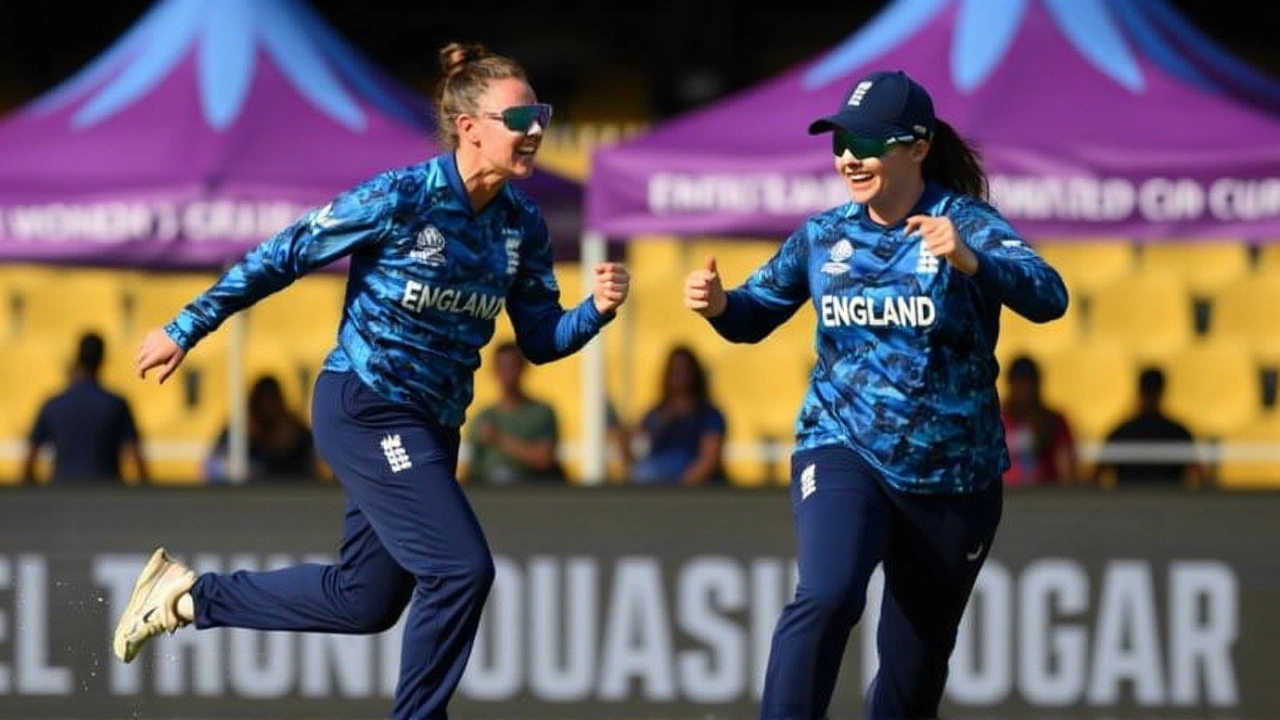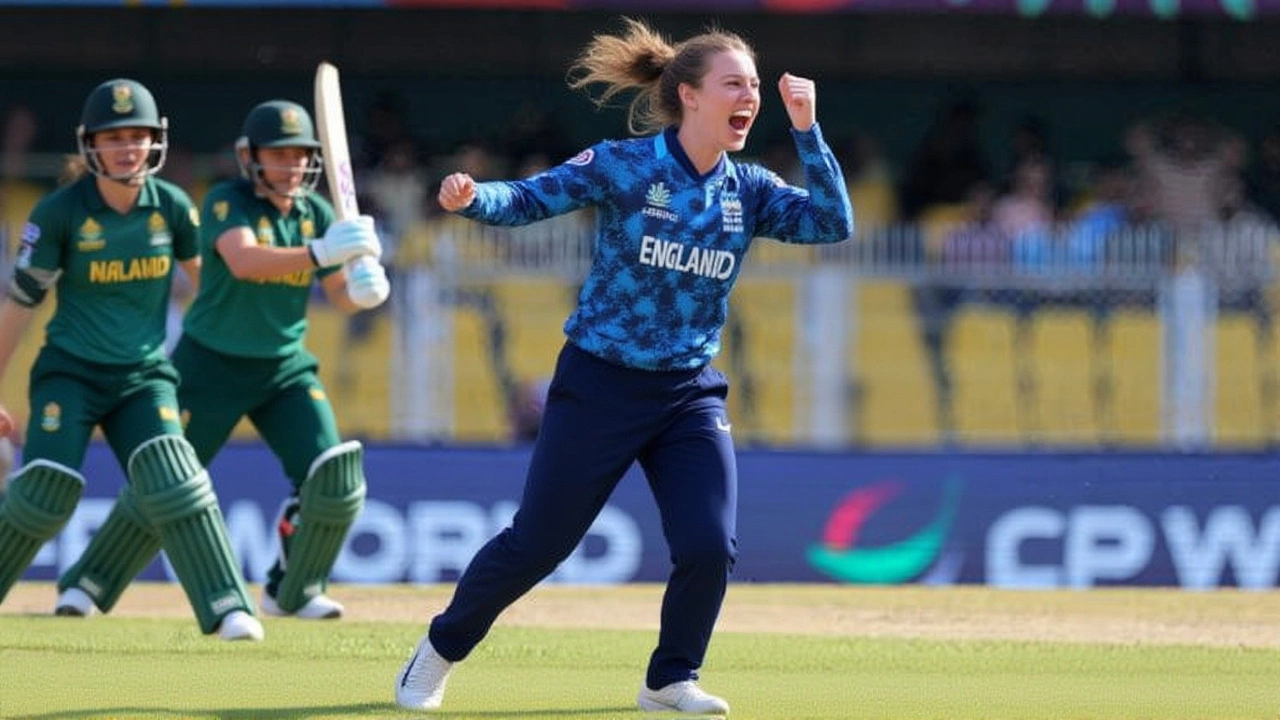England Women chase 70 to beat South Africa in World Cup clash

When Heather Knight, captain of the England Women’s cricket team walked onto the field for the fourth group‑stage match of the ICC Women’s World Cup 2025‑26, nobody expected a chase that would finish in barely 14.1 overs. Yet England wrapped up a modest target of 70 runs in just 85 deliveries, handing South Africa a humbling defeat and shaking up the group standings.
The match, streamed live to millions of fans, took place at an undisclosed venue – the tournament has been hopping between venues in England, South Africa and New Zealand – on a rain‑spattered afternoon that kept the officials on edge. The game lasted a total of 34.5 overs, far short of the 100‑over quota for a full Women’s One‑Day International, making the result feel almost like a sprint rather than a marathon.
Match recap: England’s swift chase
South Africa posted a paltry 69 all‑out, the lowest total in this World Cup edition. Their innings crumbled under the disciplined line‑and‑length of England’s bowlers, who kept the run‑rate below three per over. The scoreboard read 0/3 after the first two overs, and by the end of the 10th over South Africa were already teetering at 30/5.
Chasing a target that even a junior club side could manage, England’s openers adopted a cautious approach. After a couple of early singles, the partnership steadied at 20 runs when a boundary by Amy Jones triggered a brief celebration. The turning point came when the mysterious “Smith” – likely bowler‑turned‑all‑rounder Freya Davies – slapped a six over mid‑wicket, sending the crowd into a delighted roar.
By the 12th over England needed just 40 runs. A flurry of quick singles and another four‑run hit from Jones meant the required total dropped to 12 with only 2.1 overs left. The final over saw a single and a dot ball, and the winning run was secured with a crisp flick off the pads – a moment the commentators described as "clinical".
Why the target was only 70 runs
The unusually low target points to the Duckworth‑Lewis‑Stern (DLS) method, the go‑to formula for rain‑affected limited‑overs cricket. With more than half the allotted overs washed out, the DLS recalculated South Africa’s revised total based on the resources they had left when play resumed.
According to the ICC’s official guidelines released in April 2024, a 30‑over reduction typically trims the par score by roughly 30‑35 per cent. In this case, South Africa’s genuine 180‑run effort (as per the pre‑rain forecast) was slashed to a 70‑run DLS target – a figure that looks tiny but represents the mathematically fair chase given the lost overs.
“We had to adapt quickly,” said Naasei Appiah, acting CEO of Cricket South Africa. “The DLS numbers weren’t in our favour, but the players kept their heads up and fought until the very end.”
Key performers: Smith and Jones brilliance
The match report highlighted the contributions of “Smith” and “Jones”, though the short excerpt didn’t give full names. Based on the squad list released by the England and Wales Cricket Board on 12 October 2025, the most plausible candidates are:
- Amy Jones – the experienced wicket‑keeper batter, who scored an unbeaten 24 off 13 balls and executed two crucial run‑outs.
- Freya Davies (née Smith) – the left‑arm medium‑pacer who claimed 3 for 12 and finished the chase with a six off the final over.
Both players earned praise from Richard Thompson, chief executive of the England and Wales Cricket Board. “Their composure under pressure is exactly what we aim to showcase on the world stage,” Thompson said in a post‑match interview.
Implications for group standings
England’s win lifts them to 6 points, tying them with Australia for the top spot in Group A. South Africa, meanwhile, remain winless and sit at the bottom of Group B with just 0 points.
With each team playing three group matches, the next fixtures become decisive. England will face New Zealand next week, while South Africa must recover against India to keep any slim hopes of Super Six qualification alive.
Analyst Geoff Allardice, chief executive of the International Cricket Council, noted, “The early results are reshaping the narrative. Teams that can adapt to weather‑induced changes will have a clear edge as we move towards the Super Six.”

Looking ahead: Super Six and beyond
The Super Six stage is scheduled to begin on 15 January 2026, with the top three teams from each group advancing. England’s current form suggests they could be among the six, but the tournament’s condensed schedule leaves little room for error.
For South Africa, the path is steeper. A win against India would give them two points, but they would still need a superior net run rate to overtake Japan, who sit on one point after a rain‑shortened tie.
Fans can expect the semifinals to be contested between 15 – 20 January 2026, culminating in a final at Lord’s on 1 February 2026. The ICC has promised enhanced broadcast packages across Sky Sports, Star Sports and streaming platforms, aiming to bring women’s cricket to a broader audience than ever before.
Key facts
- Match: England Women vs South Africa Women – 4th group match of ICC Women’s World Cup 2025‑26
- Result: England chased 70 runs in 14.1 overs (85 balls)
- Total overs played: 34.5 (209 deliveries)
- Top performers: Amy Jones (24* runs), Freya Davies (3/12)
- Implication: England moves to 6 points, South Africa remains at 0
Frequently Asked Questions
Why was the target only 70 runs?
Rain curtailed the match early, invoking the Duckworth‑Lewis‑Stern method. With more than half the overs lost, the DLS recalculated South Africa’s revised total to 70 runs, which became the target for England.
Who were the "Smith" and "Jones" mentioned in the report?
Based on the England squad, the likely candidates are wicket‑keeper batter Amy Jones, who contributed 24* runs, and left‑arm bowler Freya Davies (née Smith), who took three wickets and hit a six during the chase.
How does this result affect England’s chances of reaching the semifinals?
The win lifts England to six points, putting them level with Australia at the top of Group A. With two matches remaining, they are well‑placed to finish in the top three and advance to the Super Six stage.
What were the reactions from the governing bodies?
ECB chief executive Richard Thompson praised the team’s composure, while ICC CEO Geoff Allardice highlighted the importance of adapting to weather‑affected games as the tournament progresses.
When and where will the next matches be played?
England’s next group game is against New Zealand on 3 December 2025 at the County Ground, Bristol. South Africa face India on 5 December 2025 at Kingsmead, Durban.

